This moisturizing cold process soap recipe is the perfect bar of soap for dry hands or the body. Made with cocoa butter, coconut oil, and shea butter, it is very soothing and gentle for dry skin.
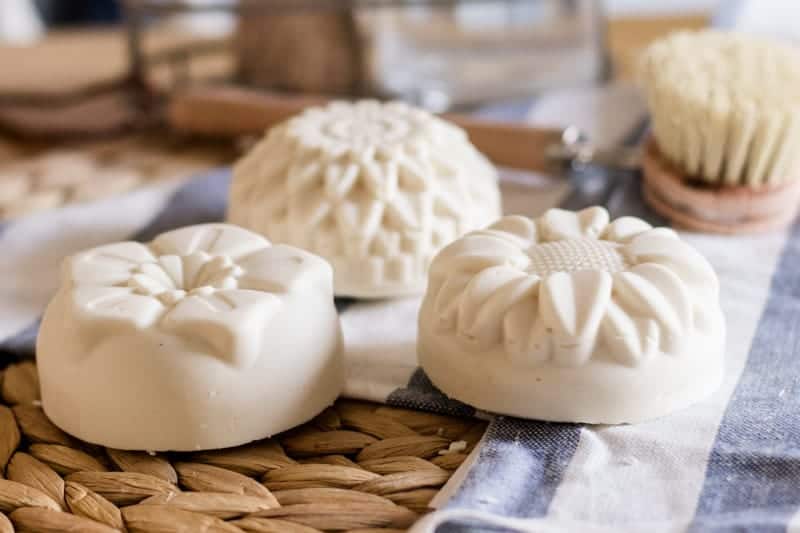
Making handmade soap bars has become a new hobby of mine. From shampoo bars to body soap bars, I find that making my own soap is a great way to save money and make a natural product.
This recipe is great for a hand soap bar and is super moisturizing! I especially love using this during the winter months when my hands are drier from the cooler weather.
Making your own handmade soap bars can be very easy, as long as you follow a few safety guidelines. Don’t worry; it is much easier than you think!
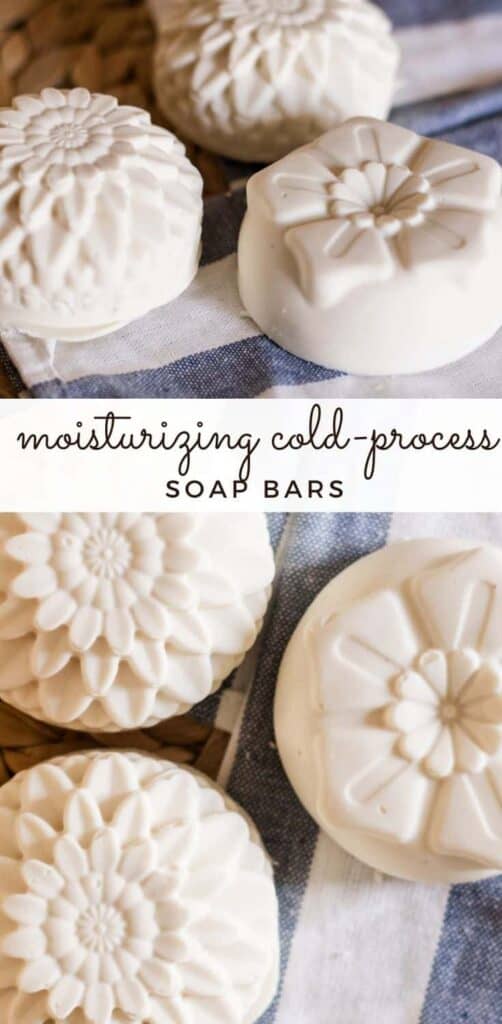
MOISTURIZING COLD PROCESS SOAP
One thing worth noting, cold process soap bars can be fully customized using a soap calculator. Punch in the ingredients that you want to use, and it will factor in the percentages of those ingredients needed as well as the lye and water.
I have made melt and pour soap bars and tallow soap bars, but I wanted to make a moisturizing cold process soap bar specifically for dry skin for this recipe.
Shea butter is very moisturizing for the skin. I also included cocoa butter and coconut oil as well. Together these ingredients make up a very moisturizing homemade soap bar.
INGREDIENTS NEEDED TO MAKE HOMEMADE SOAP
To keep this recipe easy, I am only using 5 ingredients: cocoa butter, coconut oil, shea butter, lye, and water.
COCOA BUTTER
I love using cocoa butter on my skin. In fact, you will find it in my whipped body butter, deodorant, and lip balm. It is uber moisturizing and rich in essential vitamins for healthy skin.
Cocoa butter forms a protective barrier on the skin, trapping in moisture. It can protect the skin against sun damage, slow down the signs of aging, and improve blood flow.
As a bonus, cocoa butter smells absolutely amazing! It smells like chocolate and is used to make delicate desserts, so yeah, it is included in this recipe.
COCONUT OIL
Similar to cocoa butter, you will find coconut oil in many of my skincare recipes. I use coconut oil in my anti-aging face cream and eye cream because it is excellent at reducing wrinkles and fine lines.
Coconut oil is also very moisturizing to the skin and can add hydration to dry damaged skin. It is very gentle and can be used on someone with sensitive skin.
SHEA BUTTER
Shea butter is another great moisturizer to add to this handmade soap bar. I use shea butter lotion during the winter to help add moisture to my dry skin.
Shea butter has a high concentration of fatty acids and vitamins that can help soften the skin.
Like the other ingredients found in this soap bar, shea butter is also good for sensitive skin, making these soap bars great for both adults and kids.
LYE
Lye is needed to make any soap bar. When lye is mixed with fats, soap is made. Lye is very dangerous on its own, but it is safe for the skin once it is mixed with the fat.
When dealing with lye, it is important to use proper safety gear like eye protection, long sleeves, and gloves. If possible, mix lye outdoors, or at the very least, in a well-ventilated room to avoid breathing it in.
WATER
When you make soap, you will need a liquid to mix with the lye. In most soap recipes, this must be water. Common alternatives include goat milk and coconut milk.
It is important to use distilled or filtered water. Regular tap water can often have chemicals, including chlorine, which could cause issues when interacting with the lye.
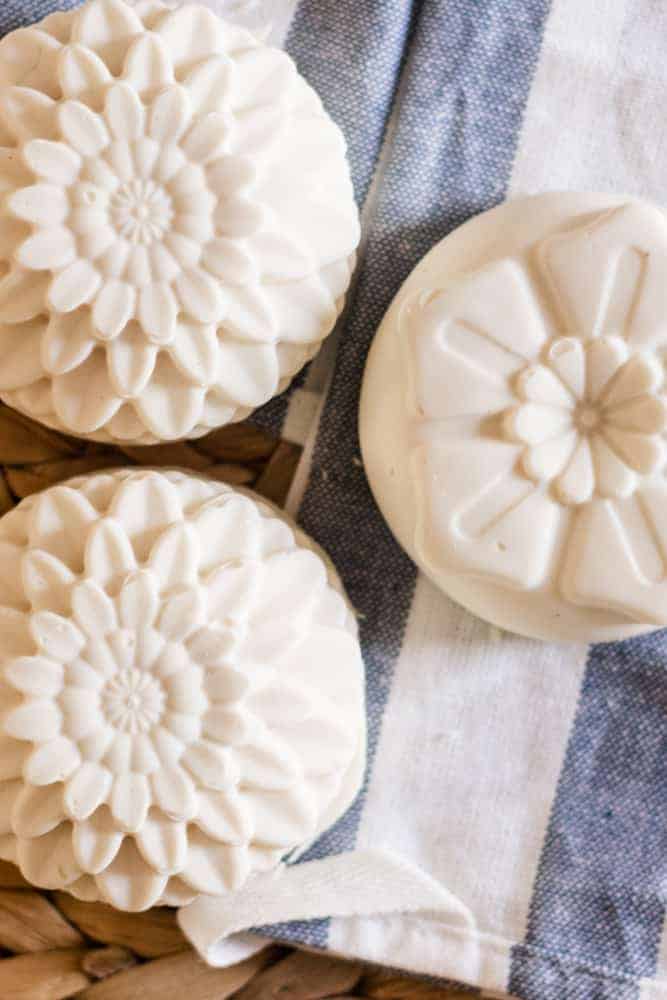
TOOLS NEEDED TO MAKE MOISTURIZING COLD PROCESS SOAP BAR
This post contains affiliate links, which means I make a small commission at no extra cost to you. As an Amazon Associate, I earn from qualifying purchases. Get my full disclosure HERE.
- Soap mold
- Immersion Blender
- Digital scale
- Glass bowl
- Gloves
- Eye protection
MOISTURIZING SOAP BAR RECIPE
I used a soap calculator to get these exact measurements. If you want to change up the recipe at all, you will need to get new measurements as it is imperative to use the exact amounts.
INGREDIENTS
- 6 ounces cocoa butter
- 5 ounces coconut oil
- 5 ounces shea butter
- 2.26 ounces lye
- 5.05 ounces water
- 15-20 drops essential oils, optional
INSTRUCTIONS
- Using a digital scale, measure out your water and pour it into a heat-resistant glass or metal.
- Measure out the lye and add it to the water. Stir the lye into the water slowly and stir until it dissolves. Note, the chemical reaction will cause it to heat up quickly.
- Using the digital scale, measure out the cocoa butter, coconut oil, and shea butter. Pour into a saucepan and melt over medium heat.
- Once the ingredients are melted, allow them to cool back down to 100 degrees.
- Once the fats reach 100 degrees, it is time to mix the lye water with the oils. Slowly add the lye and water to the oils, mix with an immersion blender. This will take a couple of minutes. You will know it is the right consistency when the soap from the blender drips and pools up at the top of the soap in the saucepan. This is known as the trace.
- If using essential oils, add those in now. Stir well.
- Pour the soap into the soap molds. If using silicone soap molds, you don’t have to do anything to them before pouring them in. Other molds may require parchment paper.
- Allow the soap to harden and sit in the molds for at least 24 hours or up to 3 days.
- Remove the soap from the molds and allow it to cure for 3-4 weeks before using.
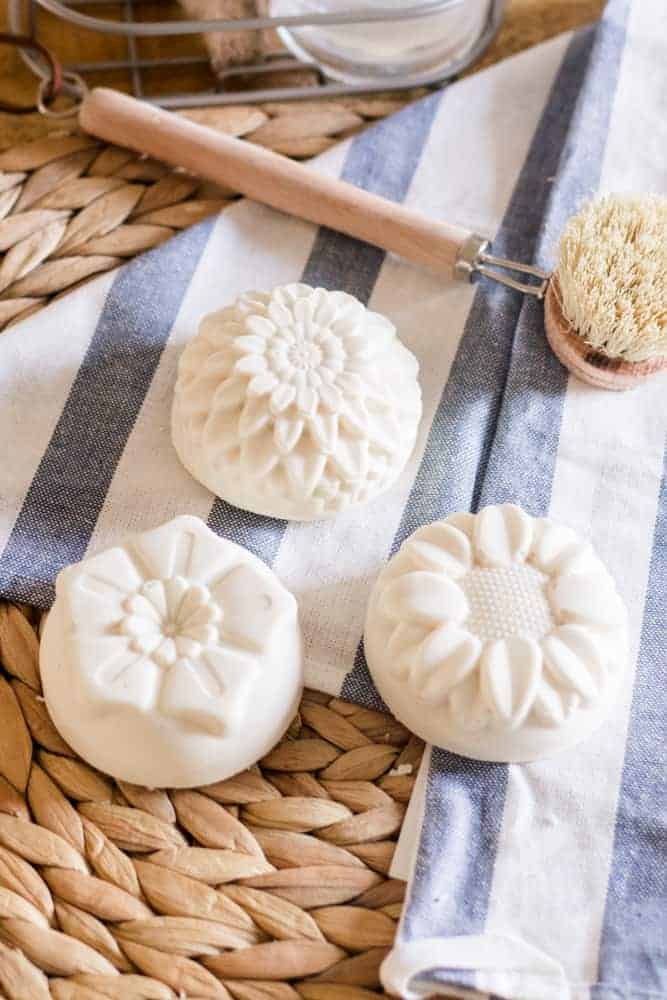
HOW TO CURE SOAP?
You can use a soap curing rack or just place the soap on a glass dish. Make sure the bars are not touching each other. I don’t have a curing rack yet, so I just stand the soap bars upright in a glass baking dish. Place them in a dry, cool, dark place for several weeks.
Curing soap is the process of allowing the soap bars to fully dry and to allow the process of saponification to finish. This typically takes 3-6 weeks. The longer it cures, the dryer the bar will be and the longer it lasts.
It is important to cure the soap before putting it in the shower, so it doesn’t melt and it will last longer.
Interested in more soap bars? Try these:
- Melt and Pour Goat Milk Soap Bars
- Shampoo Bars
- Dish Soap Bars
- Clear Glycerin Bars
- Shave Soap Bar
- Hibiscus Infused Loofah Bars
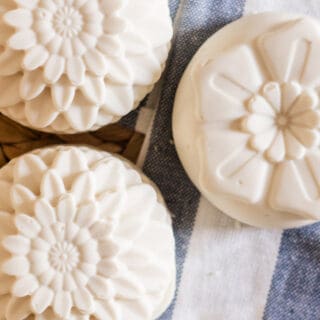
Moisturizing Cold Process Soap Recipe
Equipment
- Soap mold
- Glass Bowl
- Gloves
- Eye protection
Ingredients
- 6 ounces cocoa butter
- 5 ounces coconut oil
- 5 ounces shea butter
- 2.26 ounces lye
- 5.05 ounces liquid
- 15-20 drops essential oils optional
Instructions
- Using a digital scale, measure out your water and pour it into a heat-resistant glass or metal.
- Measure out the lye and add it to the water. Stir the lye into the water slowly and stir until it dissolves. Note, the chemical reaction will cause it to heat up quickly.
- Using the digital scale, measure out the cocoa butter, coconut oil, and shea butter. Pour into a saucepan and melt over medium heat.
- Once the ingredients are melted, allow them to cool back down to 100 degrees.
Once the fats reach 100 degrees, it is time to mix the lye water with the oils. Slowly add the lye and water to the oils, mix with an immersion blender. This will take a couple of minutes. You will know it is the right consistency when the soap from the blender drips and pools up at the top of the soap in the saucepan. This is known as the trace. - If using essential oils, add those in now. Stir well.
- Pour the soap into the soap molds. If using silicone soap molds, you don’t have to do anything to them before pouring them in. Other molds may require parchment paper.
- Allow the soap to harden and sit in the molds for at least 24 hours or up to 3 days.
- Remove the soap from the molds and allow it to cure for 3-4 weeks before using.
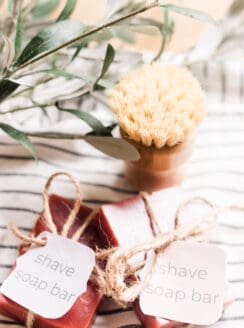
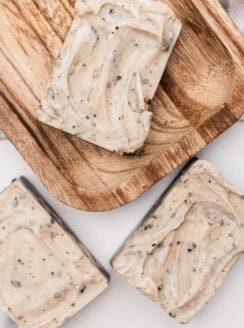
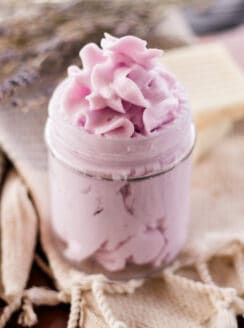
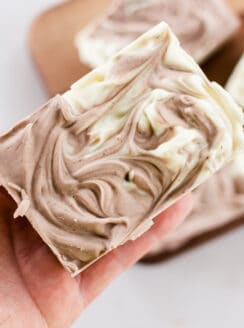
Jeanie says
Hi, I look forward to making this as my 1st homemade soap. Do we use raw, unrefined butters and oil? Many thanks
Laura says
I have everything I use linked in the blog post.
Raychel says
Hi! How much soap does this make? I have 44oz molds and I’m trying to figure out how much to multiply the ingredients by. Thanks!
Chelsea says
Hi
I’m just now starting to get into soap making can you use fragrance oil instead of essential oils ? Or would that change the ounces in the other ingredients ?
Laura says
It is best to use essential oils to keep the recipe all-natural. IF you make any changes you can use the soap calculator to adjust the recipe.
Mohammad says
Hi, What part of the soap recipe should be changed to be suitable for dry skin, normal skin or oily skin? Should I just change the amount of supper fat or change the amount of cleansing? Or it dose not related
can cbd cause depersonalization says
how long does 25 mg cbd gummy last
jane says
40 minutes
Ragen Hamlin says
If I wanted to use Fragrance oil, how fb would I use? My bottle says up to 4%.
Christina says
Thank you for the recipe.
Can I use vanilla to add a strong vanilla scent to the soap instead of essential oils?
Which type of thermometer do you use to check that it has gone down to 100 degrees?
Thank you for your help.
Laura says
Yes, you can!
Liz says
Hi,
what are your percentages On oils ?
Sandra Burnett says
Hello,
love how you explain soap making. Can I use for liguid when making shampoo hair bars fenugreek water mix instead of just distill water? Fenugreek water mix is fenugreek seeds that I let seat in distill water for two days and then the fenugreek seeds are removed.
Another question not related to the Lyle question. When it comes to adding powder herbs into all your ingredients. Do the herbs need to be measured or can you just add as much as you like?
One more question. Is it ok to add olive oil and coconut oil together in a hair shampoo bar recipe along with other oils?
Sandra Burnett says
I love how you explain soap making. Can I use for my liguid fenugreek water? Fenugreek water is fenugreek seeds that have seat in distill water for two days and then the fenugreek seeds are removed.
Also, is it ok to add olive oil and coconut oil together in a hair shampoo bar recipe along with other oils?
Laura says
I would add the fenugreek when you add in the essential oils. If you change the recipe, you can use the soap calculator to adjust the measurements accordingly.
Shilpa says
Hey Laura, Thanks so much for the recipe. What is the water discount in this recipe? I want to make it for my baby and just want to be doubly sure.
Nashima says
Hi Laura. How many grams does this procedure can produce? With you measurements above.
ally says
How many bars of soap does this recipe make?
David Johnson says
Where do you buy the ingredients?
Laura says
I have the ones I used linked.
Ruth says
When do you cut the soap into bars and how big of a mold do you need for the recipe?
Laura says
I have a soap-making set with a mold and a cutter. I have it linked in my amazon shop: https://www.amazon.com/shop/ouroilyhouse